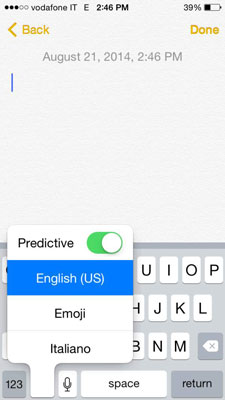The default keyboard on the iPhone has the classic QWERTY format. If you write in a language other than English, however, you’ll want to add a keyboard that reflects the alphabet of the language you want to type in — and recognizes words in that preferred language. You’ll get crazy suggestions if you type in Swedish with an English keyboard and dictionary.
You can activate other options, too, such as auto-correct and spellcheck, and the new iOS 8 feature, predictive text.
Adding languages
Your iPhone comes with two languages activated: English (or the language of the country where you purchased your iPhone) and Emoji, which lets you add smiley faces, hearts, monkeys, and flowers to your text. To add keyboards for additional languages, do the following:

Open the Settings app, tap General, tap Keyboard, and tap Keyboards.
Tap Add New Keyboard to add another language-specific keyboard.
A list of languages opens. Many languages have multiple options, such as the Chinese handwriting option or the Swiss or Canadian French option.
Tap the language you want to add.
It automatically appears in the list of keyboards.
Repeat Steps 2 and 3 to add other languages or tap Keyboard in the upper left to return to the Keyboard settings.
To change the keyboard layout, tap English or whichever language’s keyboard you want to edit.
The screen opens and displays options such as QWERTY or QWERTZ for the Software Keyboard Layout (that is, the keyboard on your iPhone). You can choose the Software Keyboard Layout you’re used to using.
Swipe right or tap Keyboards in the upper left to return to the Keyboards settings.
To rearrange the order of the languages, touch and drag the rearrange button to move the languages to the order you want. To delete a language, tap Edit, and then tap the red and white minus sign to the left of the language. Tap the Delete button that appears.
Activating keyboard options
You also have some other optional keyboard functions that you activate, or deactivate, in the Settings app. These options apply to all the keyboards you add to your iPhone. Follow these steps to change the options:
Open the Settings app.
Tap General and then tap Keyboard.
You can turn the following functions on or off.
Auto-Capitalization: Automatically capitalizes the letter I when it stands alone and capitalizes the first letter after any punctuation that iPhone recognizes as a new sentence.
Auto-Correction: Automatically corrects words as you’re typing using iPhone’s built-in dictionary. For example, if you type jome, “home” appears in a box above the word. If you tap the spacebar, the Return key, or a punctuation key, the suggestion is accepted; tap the X on the box, or just keep typing to complete your word, and your typed word remains.
The dictionary automatically adds names from Contacts, so it recognizes many names you type. Your iPhone learns your idiosyncrasies, adding words you type frequently, that it doesn’t know, to the dictionary.
Check Spelling: iPhone underlines words it thinks are spelled wrong. Tap the underlined word, and iPhone shows you possible replacement words. Tap the one you want or tap elsewhere on the screen to decline. If iPhone thinks the word is spelled wrong but doesn’t have a suggestion, a flag reads No Replacement Found and you have to correct the word, if necessary, on your own.
Enable Caps Lock:When this is on, you can quickly tap twice on the Shift key and it changes to a Caps Lock key.
Predictive: Tap on to activate the QuickType function, which is the writing equivalent of speed reading — rather than type letter for letter, you tap a whole word. As you type, three words appear above the keyboard. If you see the word you want to use, tap it instead of typing it out.
The Predictive option offers words that commonly follow other words. The predictive keyboard also learns and remembers phrases you use often. Predictive text is available in general text fields, such as the body of a message or email but not in constrained text fields, such as an email address or URL.
“.” Shortcut: Double-tapping the spacebar inserts a period and then one space.

Tap Shortcuts.
Shortcuts let you type a few letters that your iPhone interprets and expands into a longer phrase. For example, type omw in a message and it becomes “On my way!” Type your text in the Phrase and Shortcut text fields and then tap Save.
If you add a word or phrase to Shortcuts without typing in the shortcut, the word or phrase is added to your Personal Dictionary and iPhone won’t make suggestions for correcting it.
When you turn Documents and Data on in iCloud, your shortcuts sync between iOS devices and your Mac, if you use one.
Tap General in the upper left, and then Settings in the upper left to return to the main Settings screen, or swipe right until you reach the screen you want.
Switching between languages
To simply switch from English to Emoji, tap the Emoji key. If you have more than one language activated, you see a Globe key instead of the Emoji key. Tap the Globe key to switch between languages; each tap takes you to the next language. The languages are in the same order as your keyboards are listed in Settings.
Tap and hold the Emoji/Globe key to open a pop-up list of English, Emoji, and any languages you added, as well as the option to turn Predictive text on or off. Tap to select the language you want to use or tap the Predictive switch to the on or off position. Even if you enabled predictive typing in the Settings app, you can tap it on or off while typing.






